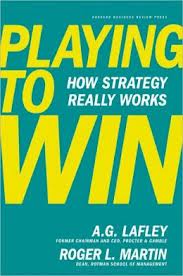Playing to Win: How Strategy Really Works

– By A. G. Lafley and Roger L. Martin
- G. Lafley was the former Chairman of the Board, President, and Chief Executive Officer of Procter & Gamble. Under his watch – during the noughties – P&G more than doubled its sales and quadrupled its profits. Also, P&G’s portfolio of billion-dollar brands grew from 10 to 24. The company’s market capitalisation during this period also doubled, making P&G one of the five most valuable companies in USA. Professor Roger Martin is the Dean of the Rotman School of Management and a prolific writer of business and management. The two have the credentials to write on strategy.
Lafley and Martin argue that business leaders don’t get the hang of strategy and approach it in many ineffective ways:
- They define strategy as a vision
- They define strategy as a plan
- They deny that long-term (or even medium-term) strategy is possible
- They define strategy as the optimization of the status quo
- They define strategy as following best practices.
The authors borrow from Michael Porter’s definition on strategy – strategy is about making specific choices to win in the marketplace. Professor Porter, in his book Competitive Strategy, had written that a firm creates a sustainable competitive advantage over its rivals by ‘deliberately choosing a different set of activities to deliver unique value.’ (For gaining a better grasp of Porter’s work on strategy and competition, do read the excellent ‘Understanding Michael Porter’ by Joan Magretta).
Lafley and Martin feel that winning should be at the heart of a strategy; they define strategy as ‘a coordinated and integrated set of five choices: a winning aspiration, where to play, how to win, core capabilities and management systems.’ These five choices comprise the ‘strategic choice cascade’, the crux of their strategic framework. They go on to explain the five choices (or interrelated questions) in detail.
The authors also discuss two additional tools to support the strategic choice process. The first is a strategic flow logic to analyse the company — specifically its industry, customers, relative position to competitors and the potential competitor response to a company’s strategic choices. The second is a “reverse engineering” process to test potential strategic choices. The authors also argue that strategy is not something that is clear-cut; it needs constant revisits and revisions. In the words of the authors, ‘the strategic choice cascade, the strategic flow logic, and the reverse-engineering process represent the strategic playbook for your organization. Rather than a simple one-way path, the plays can be complex and winding; you will need to circle back, revisit, and revise’.
Playing to Win concludes with six strategy traps that companies could fall into:
- The do-it-all strategy – the failure to make hard choices.
- The Don Quixote strategy – taking strong competitors head-on rather than choosing battles that you can win.
- The Waterloo strategy – starting multiple battles on multiple fronts.
- The something-for-everyone strategy – being too greedy.
- The dreams-that-never-come-true strategy – developing unrealistic and bombastic aspirations.
- The program-of-the-month strategy – going for an undifferentiated, generic strategy.
The authors also outline the six signs that indicate that a chosen strategy is working.
As is to be expected, Playing to Win is replete with examples from P&G, starting with how Oil of Olay was transformed from being nicknamed the ‘Oil of Old Lady’ into a booming skincare brand in its new –Olay – avatar. Other successful P&G brands are used right throughout as amplifications and case studies.
Playing to Win provides a robust framework to develop strategies that have a better chance of succeeding in the marketplace. The P&G examples provide the icing on the cake. While the crux of what the authors suggest is not new – a lot is owed to Porter’s ground breaking work – the framework is an attractive and practical one that many marketers could use to their advantage.
Rating: A
